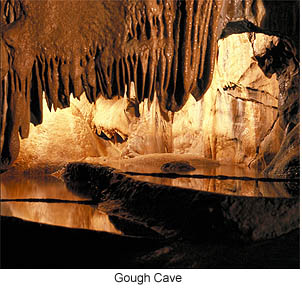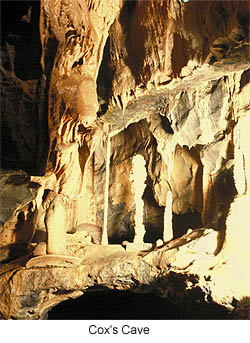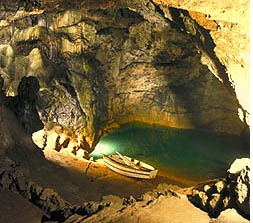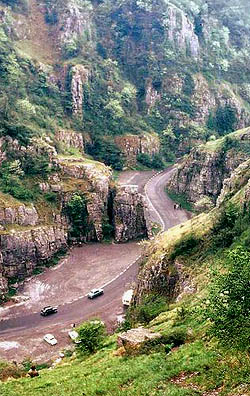Cheddar Gorge and Wookey Hole: Home of Spooks, Cannibals and Witches
by Lisa Agnew
The Cheddar Gorge in Somerset is a must-see for any enthusiast of things prehistoric. The area is known for its outstanding natural beauty, walking and climbing opportunities and its variety of cheese, but it is a vast history of continuous habitation that draws the history lover. The various caves within the Gorge have been home to Cheddar's inhabitants, prehistoric and otherwise, until the end of the 19th century, since at least 11,000 B.C.E (Before Current Era, i.e., Before Christ) and probably long before, as the finding of a 100,000 year old flint axe within the nearby village can attest.
 Within the length of the Gorge is a series of spectacular underground caves. Of most significance to a history lover is Gough Cave, rediscovered at the end of the 19th century by Richard Gough when he started exploring the mouth of a cave recently vacated by its elderly female inhabitant. Inside he found a mud and boulder choke and he laboured for six years, with the help of his six able sons, to open up the spectacular chambers hidden behind the choke. Gough's example is the largest cave, with half a mile of magnificent caverns carved out by the actions of an ancient river (there is still a river flowing beneath the cave). Within the length of the Gorge is a series of spectacular underground caves. Of most significance to a history lover is Gough Cave, rediscovered at the end of the 19th century by Richard Gough when he started exploring the mouth of a cave recently vacated by its elderly female inhabitant. Inside he found a mud and boulder choke and he laboured for six years, with the help of his six able sons, to open up the spectacular chambers hidden behind the choke. Gough's example is the largest cave, with half a mile of magnificent caverns carved out by the actions of an ancient river (there is still a river flowing beneath the cave).
It was in Gough Cave that Britain's oldest complete skeleton was discovered in 1903. A 23-year-old man had been buried in the traditional Mesolithic crouch burial position. Recent DNA testing sequenced his mitochondrial DNA (mitochondrial DNA is passed down through the female line only but is, of course, present in both genders) and determined that descendants of this man who died 9000 years ago still live in the Cheddar area! The neighboring Soldier's Hole has relinquished the oldest stone tools yet found, over 40,000 years old and perhaps of Neanderthal origin. This would have been a good place to live, offering its inhabitants a dry abode where they would have a good food supply from the land immediately surrounding them. The Gorge would have channelled animals such as horse and red deer quite close to the caves, which would have been a good position from which to set up ambushes to trap the game as it passed.
Richard Gough's uncle George Cox also discovered a cave, duly named after him, that highlights some fantastic calcite rock formations. Another local constructed Jacob's Ladder, a flight of 274 steps up to the heights to take in awe-inspiring views of the surrounding Mendip Hills. There have also been persistent stories of a 'lost cave', rumors exacerbated by occasional floodwaters flushing out tantalizing hints of undiscovered finds and the 1985 revelation by cave divers of a route down to the river still running below Gough's Cave.
 Other finds have gruesome connotations. Human bones have been discovered with incision marks on them, apparently created by stone tools. Most of these marks occur on the edge of the mandible or the side of the head at the jaw line, and on the back of the neck along the vertebrae. The marks conform to butchering incisions found on animal bones, where the hunters have taken the bones apart and smashed the longer limb bones to extract the marrow. The markings and breakages on animal and human bones at this site are exactly the same -- the conclusion being that they were probably eating the human bones as well. Methods of disposal at the site show that all the different forms of rubbish were arbitrarily mixed. If cannibalism was practiced, it may have been in the form of a ritual sacrifice. There may have been a severe shortage of food for a time. Until more finds are made, we will not know for sure. Other discoveries, however, point to the relative sophistication of the caves' inhabitants, such as a piece of rib cut and shaped with a series of notches suggesting that it had been made into some kind of counting device, or perhaps a basic calendar. Other finds have gruesome connotations. Human bones have been discovered with incision marks on them, apparently created by stone tools. Most of these marks occur on the edge of the mandible or the side of the head at the jaw line, and on the back of the neck along the vertebrae. The marks conform to butchering incisions found on animal bones, where the hunters have taken the bones apart and smashed the longer limb bones to extract the marrow. The markings and breakages on animal and human bones at this site are exactly the same -- the conclusion being that they were probably eating the human bones as well. Methods of disposal at the site show that all the different forms of rubbish were arbitrarily mixed. If cannibalism was practiced, it may have been in the form of a ritual sacrifice. There may have been a severe shortage of food for a time. Until more finds are made, we will not know for sure. Other discoveries, however, point to the relative sophistication of the caves' inhabitants, such as a piece of rib cut and shaped with a series of notches suggesting that it had been made into some kind of counting device, or perhaps a basic calendar.
Cheddar's history is not all prehistoric. The area is recorded in the will of King Alfred about 880 AD, when it was known as Ceodre. By 1086, and the time of the Domesday Book, Cheddar was under crown ownership and the village was at the center of a mediaeval forest, subject to Forest Law. The village seems to have prospered in the 13th century, when its cheese was already famous. By the middle of the 14th century, however, the Black Death and subsequent famine had bled the area of its riches. Today, the village's church of St Andrew is worth a look, built on the site of a large Roman building, possibly a villa. Its present stonework is largely from the 14th century, with the tower dating from the 15th century. Also dating from the 15th century is the stone cross at the confluence of three roads within the village, marking the site of a weekly market and twice yearly fairs (unfortunately now defunct).
Wookey Hole and the Witch's Parlor
 Six miles south-east of Cheddar Gorge, along the main Wells Rd (the A371), on a minor road about a mile or so outside the town of Wells is Wookey Hole, a series of caves inhabited for some 70,000 years. The first ever cave dive in Britain was made in the Witch's Parlour cavern of the Wookey Hole in 1935. Twenty five caverns have so far been discovered, with further exploration still pending. The cave's most notorious inhabitant is its witch, who can still be seen at the bottom of Hell's Ladder, on the shore of the subterranean River Axe, her eyes fixed on the river. Of course, she has been turned to stone now. According to folklore, a monk from Glastonbury faced her in her lair and sprinkled her with holy water, thus petrifying her and making it safe for the cave- and history-loving public to explore her former home. In 1912, an archaeologist named Herbert Balch found the almost complete skeleton of an old woman, the bones of two goats, a dagger, some household items and a polished alabaster ball among other Iron Age remains near the entrance to the Hole. Whether or not these remains have any tie-in with the legend of the witch makes for interesting conjecture. Six miles south-east of Cheddar Gorge, along the main Wells Rd (the A371), on a minor road about a mile or so outside the town of Wells is Wookey Hole, a series of caves inhabited for some 70,000 years. The first ever cave dive in Britain was made in the Witch's Parlour cavern of the Wookey Hole in 1935. Twenty five caverns have so far been discovered, with further exploration still pending. The cave's most notorious inhabitant is its witch, who can still be seen at the bottom of Hell's Ladder, on the shore of the subterranean River Axe, her eyes fixed on the river. Of course, she has been turned to stone now. According to folklore, a monk from Glastonbury faced her in her lair and sprinkled her with holy water, thus petrifying her and making it safe for the cave- and history-loving public to explore her former home. In 1912, an archaeologist named Herbert Balch found the almost complete skeleton of an old woman, the bones of two goats, a dagger, some household items and a polished alabaster ball among other Iron Age remains near the entrance to the Hole. Whether or not these remains have any tie-in with the legend of the witch makes for interesting conjecture.
 The new Sound and Light Show has recently been opened, with visual effects from Patrick Watkinson Design and sounds from RealWorld (the company of legendary musician Peter Gabriel, who is a native of the region). The lights are used to enhance the natural beauty of the cave's rock formations, giving visitors a chance to truly marvel at the scale of nature's sculpture here beneath the earth. However, only some of the caverns are open to the public as many are only accessible to experienced divers, submerged as they are beneath the waters of the river. The new Sound and Light Show has recently been opened, with visual effects from Patrick Watkinson Design and sounds from RealWorld (the company of legendary musician Peter Gabriel, who is a native of the region). The lights are used to enhance the natural beauty of the cave's rock formations, giving visitors a chance to truly marvel at the scale of nature's sculpture here beneath the earth. However, only some of the caverns are open to the public as many are only accessible to experienced divers, submerged as they are beneath the waters of the river.
In October, Wookey Hole plays host to Spook Nights, capitalising on the cave's eerie reputation. Phone 01749 67 22 43 to find out the current schedule and book a place.
How to Get There:
Cheddar Gorge is south-west of Bristol, which is off the M4 motorway. Take the A38 out of Bristol to Axbridge, then go a short way down the A371 to the B3135, which is the actual road through the Gorge itself. As mentioned in the article above, Wookey Hole is further down the A371, turning left at the village of Easton. A word of warning -- Cheddar Gorge especially can get very crowded in the high tourist season as it attracts not only history buffs but nature lovers of all descriptions.
More Information:
We regret that we no longer have the resources to maintain up-to-date links and/or hours and pricing details for the various sites and attractions listed on this website. For more information about the location(s) listed above, please use your favorite search engine or visit Wikipedia.
Lisa Agnew is a freelance writer of articles and speculative fiction. She is based in Auckland, New Zealand. English by birth, she harbours a life-long fascination with the history and folklore of her native land.
Article © 2005 Lisa Agnew
Cave photos © Britainonview.com; Gorge photo courtesy of Wikipedia.org
|
